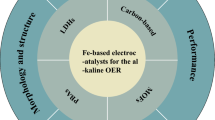Abstract
Excessive carbon dioxide (CO2) emission has caused problems associated with environmental pollution and climate deterioration. As a consequence, the selective conversion of CO2 into liquid fuels by artificial photosynthesis has gained increasing attention. However, the rational design of photocathode to achieve selective CO2 photoelectroreduction is challenging. Here, we sensitized cuprous oxide (p-nCu2O) loaded on hydroxyl iron oxide (FeOOH) with cobalt-doped cadmium sulfide (Co:CdS) quantum dots to prepare a novel photocathode FeOOH/p-nCu2O/Co:CdS by sequential electrodeposition and chemical bath deposition. The composite photocathode exhibited a larger photovoltage, which is 1.9 times higher than the pristine counterpart, and was efficient for CO2 reduction to produce formic acid with high selectivity of up to 82.9% (Faradaic efficiency). Theoretical calculations revealed that the photocathode out-layer Co:CdS quantum dots had increased binding energy toward the key intermediate *OOCH through additional hybridization orbitals to exclusively favor the formation of formic acid. An impurity energy level was revealed to form by doping Co to the CdS-containing composite, which could reduce the photocathode band gap with improved absorption toward visible light, thus remarkably increasing the photoelectrochemical properties. This is the first work undertaking the energy band structure optimization of the photocathode enabled by elemental doping to improve its photoelectrocatalytic performance.




Similar content being viewed by others
References
Abdullah H, Khan MMR, Ong HR, Yaakob Z (2017) Modified TiO2 photocatalyst for CO2 photocatalytic reduction: An overview. J CO2 Util 22:15–32. https://doi.org/10.1016/j.jcou.2017.08.004
Cao Y, Guo L, Dan M, Doronkin DE et al (2021) Modulating electron density of vacancy site by single Au atom for effective CO2 photoreduction. Nat Commun 12:1675–1685. https://doi.org/10.1038/s41467-021-21925-7
Cheng C, Karuturi SK, Liu L, Liu J et al (2012) Quantum-dot-sensitized TiO2 inverse opals for photoelectrochemical hydrogen generation. Small 8:37–42. https://doi.org/10.1002/smll.201101660
Dong WJ, Navid IA, Xiao Y, Lim JW et al (2021) CuS-Decorated GaN nanowires on silicon photocathodes for converting CO2 mixture gas to HCOOH. J Am Chem Soc 143:10099–10107. https://doi.org/10.1021/jacs.1c02139
Fujishima A, Honda K (1972) Electrochemical photolysis of water at a semiconductor electrode. Nature 238:37–38. https://doi.org/10.1038/238037a0
Giribabu G, Murali G, Amaranatha Reddy D, Liu C et al (2013) Structural, optical and magnetic properties of Co doped CdS nanoparticles. J Alloy Compd 581:363–368. https://doi.org/10.1016/j.jallcom.2013.07.082
Guo R, Meng J, Lin W, Liu A et al (2021) Manganese doped eco-friendly CuInSe2 colloidal quantum dots for boosting near-infrared photodetection performance. Chem Eng J 403:126452–126460. https://doi.org/10.1016/j.jallcom.2013.07.082
Li S, Mo Q-L, Xiao Y, Xiao F-X (2023) Maneuvering cuprous oxide-based photocathodes for solar-to-fuel conversion. Coordin Chem Rev 477:214948–214976. https://doi.org/10.1016/j.ccr.2022.214948
Lin H, Luo S, Zhang H, Ye J (2022) Toward solar-driven carbon recycling. joule 6:294–314. https://doi.org/10.1016/j.joule.2022.01.001
Liu G, Zheng F, Li J, Zeng G et al (2021) Investigation and mitigation of degradation mechanisms in Cu2O photoelectrodes for CO2 reduction to ethylene. Nat Energy 6:1124–1132. https://doi.org/10.1038/s41560-021-00927-1
Pan L, Kim JH, Mayer MT, Son MK et al (2018) Boosting the performance of Cu2O photocathodes for unassisted solar water splitting devices. Nat Catal 1:412–420. https://doi.org/10.1038/s41929-018-0077-6
Rao KR, Pishgar S, Strain J, Kumar B et al (2018) Photoelectrochemical reduction of CO2 to HCOOH on silicon photocathodes with reduced SnO2 porous nanowire catalysts. J Mater Chem A 6:1736–1742. https://doi.org/10.1039/c7ta09672k
Roy K, Maitra S, Ghosh D, Kumar P et al (2022) 2D-Heterostructure assisted activation of MoS2 basal plane for enhanced photoelectrochemical hydrogen evolution reaction. Chem Eng J 435:134963–134973. https://doi.org/10.1016/j.cej.2022.134963
Shi J-W, Sun D, Zou Y, Ma D et al (2019) Trap-level-tunable Se doped CdS quantum dots with excellent hydrogen evolution performance without co-catalyst. Chem Eng J 364:11–19. https://doi.org/10.1016/j.cej.2019.01.147
Tang B, Xiao F-X (2022) An overview of solar-driven photoelectrochemical CO2 conversion to chemical fuels. ACS Catal 12:9023–9057. https://doi.org/10.1021/acscatal.2c01667
Wang Y, Zhang R, Chen J, Wu H et al (2019) Enhancing catalytic activity of titanium oxide in lithium-sulfur batteries by band engineering. Adv Energy Mater 9:1900953–1900977. https://doi.org/10.1002/aenm.201900953
Won DH, Choi CH, Chung J, Woo SI (2014) Photoelectrochemical production of formic acid and methanol from carbon dioxide on metal-decorated CuO/Cu2O-layered thin films under visible light irradiation. Appl Catal B 158–159:217–223. https://doi.org/10.1016/j.apcatb.2014.04.021
Wright JT, Forsythe K, Hutchins J, Meulenberg RW (2016) Implications of orbital hybridization on the electronic properties of doped quantum dots: the case of Cu:CdSe. Nanoscale 8:9417–9424. https://doi.org/10.1039/c6nr00494f
Zhou B, Kong X, Vanka S, Cheng S et al (2019) A GaN: Sn nanoarchitecture integrated on a silicon platform for converting CO2 to HCOOH by photoelectrocatalysis. Energ Environ Sci 12:2842–2848. https://doi.org/10.1039/c9ee01339c
Zhou M, Guo Z, Liu Z (2020) FeOOH as hole transfer layer to retard the photocorrosion of Cu2O for enhanced photoelctrochemical performance. Appl Catal B 260:118213–118222. https://doi.org/10.1016/j.apcatb.2019.118213
Acknowledgements
The study was funded by the Guizhou Provincial S&T Project (GCC[2023]011, ZK[2022]011), and National Natural Science Foundation of China (22368014).
Author information
Authors and Affiliations
Contributions
SL: Methodology, Investigation, Writing—original draft. ZG: Methodology. YY, KW and ZL: Formal analysis. P-dW: Writing—review & editing. HL: Conceptualization, Funding acquisition, Writing—review & editing. SY: Supervision.
Corresponding authors
Ethics declarations
Conflict of interest
The authors have no known competing financial interests to declare.
Additional information
Publisher's Note
Springer Nature remains neutral with regard to jurisdictional claims in published maps and institutional affiliations.
Supplementary Information
Below is the link to the electronic supplementary material.
Rights and permissions
Springer Nature or its licensor (e.g. a society or other partner) holds exclusive rights to this article under a publishing agreement with the author(s) or other rightsholder(s); author self-archiving of the accepted manuscript version of this article is solely governed by the terms of such publishing agreement and applicable law.
About this article
Cite this article
Liu, S., Guo, Z., Yang, Y. et al. Cobalt-doped CdS quantum dots enhanced photoelectroreduction of CO2 to formic acid with high selectivity. Environ Chem Lett 22, 463–470 (2024). https://doi.org/10.1007/s10311-023-01691-2
Received:
Accepted:
Published:
Issue Date:
DOI: https://doi.org/10.1007/s10311-023-01691-2




